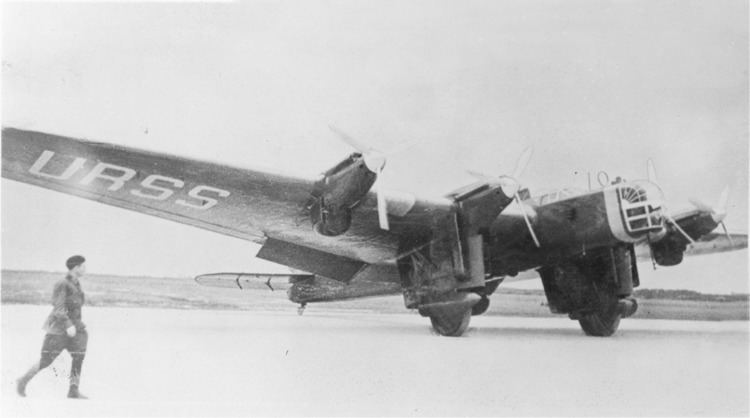Top speed 316 km/h Length 24 m | Wingspan 40 m First flight May 2, 1935 | |
 | ||
The Bolkhovitinov DB-A (Dahl'niy Bombardirovshchik-Akademiya – long-range bomber, academy) was a heavy bomber aircraft designed and built in the USSR from 1934.
Contents
Development
Bolkhovitinov became the head of the VVIA design group at the VVA Žukovskij ( - VVS academy Žukovskij ) tasked with the design of a replacement for the Tupolev TB-3 heavy bomber. The resulting DB-A was advanced for its day, with stressed skin aluminium alloy construction throughout with clean lines, neatly cowled engines and trousered main undercarriage legs, with fully retracting main-wheels and tail-wheel. The split flaps, undercarriage, nose turret and bomb-bay doors were all operated by a pneumatic system recharged by engine-driven compressors. Flight trials began on 2 May 1935 at Khodinka piloted by N.G. Kastanyev and Ya.N. Moseyev, factory tests were completed by April 1934 and NII testing was carried out in May and June 1935. The excellent performance demonstrated included, sustained flight at an altitude of 2,500 m (8,202 ft) with two engines shut down, and 4,500 km range.
A decision was made to fly nonstop from Moscow to the US, and the DB-A was modified to fly, at an overload weight of 34,700 kg (76,500 lb), carry enough fuel to fly 8,440 km (5,244 miles). The red-painted DB-A prototype under command of Sigizmund Levanevsky departed Moscow Shchyelkovo airport on 12 August 1937 on an attempt to fly to Fairbanks, Alaska. After 14 hours, 32 minutes, the crew sent a radio message that one engine had failed and gave a revised ETA for Fairbanks, but nothing further was heard from the DB-A, and the fate of the aircraft and crew remains a mystery.
A second aircraft with increased gross weight, improved airframe, re-designed nose and more power was completed and flown in March 1936 as the DB-2A. An order for 16 aircraft was placed late in 1937, with the designation DBA, but only twelve were completed due to the advent of the TB-7/Pe-8.
Variants
Specifications (DBA)
Data from Gunston, Bill. “The Osprey Encyclopaedia of Russian Aircraft 1875–1995”. London, Osprey. 1995. ISBN 1-85532-405-9
General characteristics
Performance
Armament
